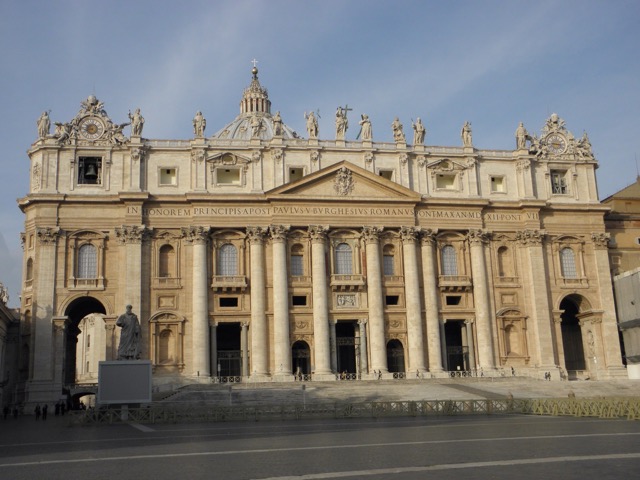After Constantine’s Edict of Milan (313 A.D.) Christians were allowed to construct places of worship. Constantine himself authorized the building of the basilica in 324. It was intended to enclose “Gaius’s Trophy” and to allow Peter’s tomb to become the centre of the structure. Consecrated in 329, the great basilica appeared as a longitudinal building with a nave, four aisles and a transept. Outside, a staircase led to the four-sided portico in front of the basilica, known also as Paradise, with a fountain in the middle for the ablutions of the catechumens.
The Constantinian basilica disappeared with time. Over 150 years passed from the decision of Nicholas V Parentucelli to enlarge and restore the ancient basilica to the completion of the Renaissance building with the façade (1612). This is quite a long period of time in terms of the number of years, but it is absolutely understandable if one remembers the enormous amount of work and the continuous changes in the planning.
In the over 150 years required to complete the basilica, the most famous artists of the time directed the “Fabbrica di San Pietro”. Among these were Raphael Sanzio, who decided to transform Bramante’s Greek cross design with a Latin cross-like structure in 1514; Antonio da Sangallo the Younger; and Michelangelo who, during the pontificate of Paul III, decided to reuse the original Greek cross plan, designed the dome and supervised its construction until his death in 1564.
Over the course of the next thirty years, the “Fabbrica di San Pietro” was directed by Giacomo Vignola, and then by the architects Giacomo Della Porta and Domenico Fontana, who completed Michelangelo’s plan of the dome around 1588. Saint Peter’s Basilica reached its present state thanks to Carlo Maderno, who went back to the Latin cross plan and defined the scenographic aspect of the façade.
Work on the basilica was completed during the pontificate of Urban VIII in 1626, but it was only between 1656 and 1667 that Bernini, commissioned by Alexander VII, planned and constructed the great colonnade in Saint Peter’s Square with the 1st century B.C. obelisk in the middle. Originally set in the centre of Caligula’s Circus, where Saint Peter was martyred, it was moved to the present site in 1585 by Domenico Fontana, who was directed to do so by Sixtus V.
Saint Peter’s Basilica can host 20,000 people. It is 190 m long, the aisles are 58 m wide, the nave is 45.50 m high as far as the vault, the dome is about 136 m high as far as the cross.
Pilgrimage to Italy 2012


